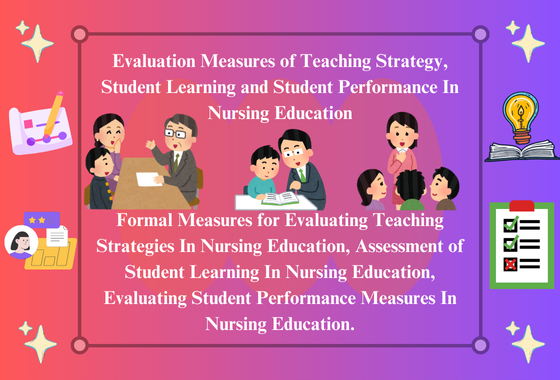The Evaluation Measures of Teaching Strategy Student Learning and Student Performance In Nursing Education. Evaluation Measures of Teaching Strategy Formal Measures for Evaluating Teaching Strategies in Nursing Education, Assessment of Student Learning In Nursing Education, Evaluating Student Performance Measures In Nursing Education.
The Evaluation Measures of Teaching Strategy Student Learning and Student Performance In Nursing Education
In nursing education, various assessment methods are used to evaluate teaching strategies, learning success, and student performance in order to measure their progress and success. These methods can be broadly divided into formative and summative methods and include tests, quizzes, projects, simulations, observations, and more. The goal is to ensure the effectiveness of teaching methods and provide students with the knowledge and skills necessary for their nursing careers.
There are two main types of assessment: formative assessment, which provides feedback during the lesson, and summative assessment, which determines success at the end through tests and projects.
Formal Measures for Evaluating Teaching Strategies in Nursing Education
Formal, objective measures of teaching strategies may include experimental or quasi experimental designs, with randomization of subjects and control of treatments. For example, a teacher may establish a control group and a treatment group to try different teaching techniques and to evaluate outcomes to prove or disprove a predetermined hypothesis.
This technique is often used when there are multiple sections of a given course, although it can be accomplished within one section. A common method is to use the traditional strategy with the control group and the new strategy with the experimental group. A common examination or other assessment measure is used with both groups.
Analysis may include checking for a significant difference in the scores of the two groups, as well as checking areas in which the most questions were missed for congruence or no congruence between the two groups. A weakness of some of these efforts is that they are context bound and not generalizable.
A strength of these testing strategies is the provision of feedback of value to evaluate questions within a given curriculum. Another measure for evaluating teaching strategies is to have faculty complete a course report. The course report provides a record of the types of instructional methods used, the rationale for choosing these methods, and results of changes to these methods.
Assessment of Student Learning in Nursing Education
It is unacceptable to claim that teaching strategies are effective unless there is evidence that links the teaching transaction with student learning. Assessment within the classroom provides evidence for interim outcome evaluation. Interim evaluation refers to outcomes of specific learning episodes, course outcomes, or level outcomes as opposed to outcomes assessed at the conclusion of the program of learning.
Glennon (2006) notes that outcomes relate directly to professional practice and differentiate this from objectives that relate to instruction. Course grades are often subjective and insufficient. Therefore, real outcomes are needed not only to assist students in learning better but also to aid faculty in better assessing student learning. (Glennon, 2006).
Both formal and informal methods may be used in the classroom to assess student progress and to evaluate the effectiveness of teaching strategies. Informal classroom assessment is useful to the teacher for determining how well students are learning. Data from the assessment can be used by the teacher in making changes to improve student learning.
This form of classroom assessment is often not graded and is anonymous to get honest feedback. However, faculty also use more formal classroom assessments that are graded to get a feel for the quality of the teaching and determine how well the students are learning, Students can use the formative assessment to set their own academic goals, compare how hard they have worked or methods used for studying with what they have learned, and to help them prepare for future assessments (Reig, 2007).
The use of formalized external testing in prelicensure programs is another option that assists in the evaluation of student learning. For example, several commercial testing products provide both content mastery and comprehensive predictor examinations that provide indicators of student learning.
These assessments provide questions similar to those that students will experience on the licensure examination and provide faculty with feedback that indicates need for improvement in specific content areas. Faculty can then provide focused review of content in which students’ scores were low. Tracking student scores in individual nursing courses also can be insightful in revising course content as well as curricula to improve student learning outcomes.
Evaluation of individual student performance must be effectively communicated to students. Documentation should provide evidence that evaluation leads to improvement in performance. This is especially important in clinical evaluation. Clinical evaluation tools should be congruent with course and program objectives. They should be designed to provide students with clear information about expectations.
The evaluation tool should clearly demonstrate the student’s performance as well as the appropriate feedback provided regarding their performance and how it can be improved. The tools should also include information about how students responded to the feedback and how behavior changed.
Evaluating Student Performance Measures in Nursing Education
In addition to documenting that teaching methods are effective, methods of evaluating student performance must be valid and reliable. Multiple-choice examinations are a common, cost-effective, and time-efficient method of testing knowledge acquisition both as students’ progress in a course and at the conclusion of the course and program. This format provides rapid, quantitative data for individual assessment and aggregate data for centralized evaluation.
Read More:
https://nurseseducator.com/didactic-and-dialectic-teaching-rationale-for-team-based-learning/
https://nurseseducator.com/high-fidelity-simulation-use-in-nursing-education/
First NCLEX Exam Center In Pakistan From Lahore (Mall of Lahore) to the Global Nursing
Categories of Journals: W, X, Y and Z Category Journal In Nursing Education
AI in Healthcare Content Creation: A Double-Edged Sword and Scary
Social Links:
https://www.facebook.com/nurseseducator/
https://www.instagram.com/nurseseducator/
https://www.pinterest.com/NursesEducator/
https://www.linkedin.com/in/nurseseducator/
https://www.researchgate.net/profile/Afza-Lal-Din
https://scholar.google.com/citations?hl=en&user=F0XY9vQAAAAJ
